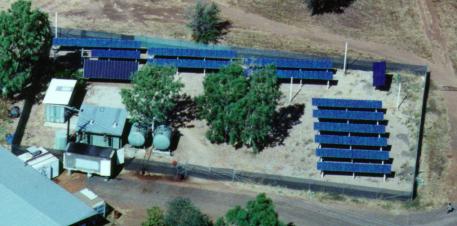
Information about the station can be found in the paper, which deals
mainly with the performance differences between the Canon amorphous and
Solarex Polycrystalline silicon cells. here are the abstract and conclusions
of the paper.
Abstract
The first commercial hybrid power station installation of Canonís triple junction amorphous silicon panels is at the Power And Water Authorityís Solar Research site in the Northern Territory remote community of Jilkminggan. The site experiences regular high ambient temperatures and high humidity in the Wet Season, which is a testing environment for any new product. This paper compares the performance of the Canon product with that of the Solarex poly-crystalline silicon panels which are also installed at this site. It details the performance differences for varying temperatures and solar radiation levels. As the arrays are connected to a working mini grid, the effects of different operating conditions on the performance of the arrays are also documented.
Conclusions
The Jilkminggan solar research facility is a fully operating power station, receiving a substantial contribution of its energy from various solar arrays. The station is located in a hot and humid zone of the Northern Territory and thus ideally suited to rigorous testing of solar products. Solarex poly-crystalline and Canon triple junction amorphous solar panels have been in-field performance tested side-by-side.
The results show that the Solarex product is twice as prone to ambient temperature induced output reductions than the Canon product. Based on rated peak power, the overall power output of the Canon product in the test environment is between 20% and 30% higher than that of the Solarex panels. This is a very substantial difference and needs to be kept in mind when either choosing or analysing the costs of solar panel products. This result does not means that the Solarex panels don't work well, they just perform worse than the Canon panels when compared with their rating in this environment.
All the tests and analysis are based on real field data. No theoretical data or assumptions have been used. As the amorphous material reacts so differently to the poly-crystalline one, a theoretical comparison will never predict the actual performance nearly as well as in-field tests such as the ones described in this paper.
Download the Paper
This paper is in Adobe pdf format and 928kb in size. Click here to download or view it.
Further Information
At the moment, no other papers or publications about this work are publicly available. Specific questions can be directed to the author Wolfgang Meike.
To go to Wolfgang Meike's home page click here.